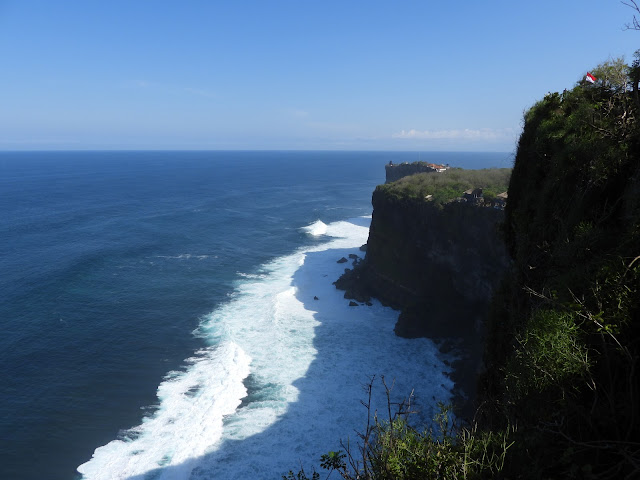Or Day 2 of our Indonesian birding and nature tour.
 |
| Zebra Dove |
6am saw us perched in the hotel lobby before a c45 minute dodge through traffic into southern Bali. We ended up not far, as the White tailed Tropic bird flies, from Uluwatu Temple where we first enjoyed a 'bush breakfast of eggs, bread and jam, bananas and, most importantly, Kopi.
Our breakfast was interrupted by birds. First flocks of the ubiquitous Yellow vented Bulbuls and then by Common Ioras, Linneated Barbets, Sooty headed Bulbuls, Ornate Sunbirds, and Zebra and Spotted Doves.
 |
| Sooty headed Bulbul |
 |
| Collared Kingfisher |
Most exciting was a fly by of two Black winged Starlings. This Balinese sub species is very sadly critically endangered and, as a result, sightings are far from assured. Mental note - research what if anything is being done for its conservation.
 |
| Linneated Barbet through condensation covered lens... |
A drip feed of species continued; Pink necked Pigeon, Sunda Collared Dove and most interestingly a sighting of Sunda or Javan Coucal. This species, until recently, was believed to be a Javan endemic, however our local Balinese guide and others have discovered it in at least three locales within Bali. All this has happened within the last 12 months.
Sunda Coucal is known to be endemic to Java Island. This report documented the sightings of Sunda Coucal Centropus nigrorufus on Bali and Madura, Indonesia. There are 7 sightings within three different areas in Bali and six different areas in Madura. These records are to be new records of Sunda Coucal which widen its distribution outside mainland of Java Island. Based on the presence of this bird in the bird market, the distance of Java and Bali or Java and Madura are very close, and no information from previous records of this species in Madura and Bali. It is presumed that this species could be a feral bird rather than an overlooked species in the past. -
Black naped Orioles were singing but remained largely elusive.
 |
| Sunda Collared Dove |
Soon we walked out to the cliff's edge on a wonderful property overlooking Uluwatu Temple and its surrounds.
Uluwatu Temple (Balinese: Pura (Luhur) Uluwatu) is a Balinese Hindu temple located on the south-western tip of the Bukit Peninsula in Uluwatu (South Kuta), Badung Regency, Bali, Indonesia. It is the only Balinese sea temple (pura segara) that is also one of the nine directional temples (Pura Kahyangan Jagat or Pura Kahyangan Padma Bhuwana). The temple (pura in Balinese) is built at the edge (ulu) of a 70-meter-high (230 ft) cliff or rock (watu) projecting into the sea. Though a small temple is claimed to have existed earlier, the structure was significantly expanded by a Javanese sage, Empu Kuturan in the 11th century. Dang Hyang Nirartha, another sage from East Java at the turn of the 16th century, is credited for introducing the padmasana shrines and it is said that he attained moksha here, an event called ngeluhur ("to go up") locally. This has resulted in the temple's epithet Luhur.
In the scrubland on the cliff tops we enjoyed a variety of butterfly species as well as some more bird species including Olive backed Tailorbird, White shouldered Triller, Scarlet Minivet, House Swift, Freckle-breasted Woodpecker and, crossing the waves below Eastern Reef Egrets.
And there were Long tailed Macaques.
Bottle nosed Dolphins - c. 20 or so in number passed by but sea birds were invisible.
We left the cliff top at about 10 am and stopped briefly near some fish markets adding Pacific Swallow and Great Crested Terns to our trip list.
An eclectic lunch at a calming air conditioning restaurant before a couple of hours downtime at our hotel before we met at 3 pm for the afternoon's programme.















%20(002).JPG)
No comments:
Post a Comment